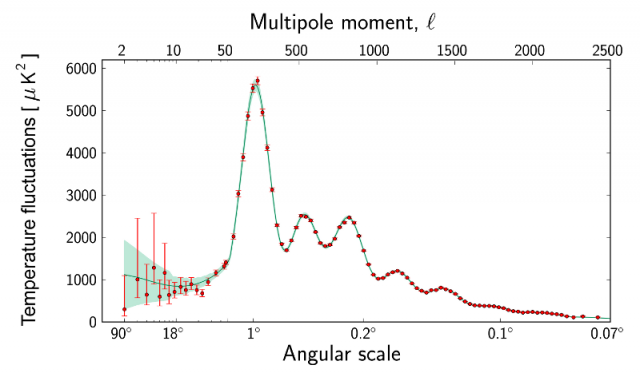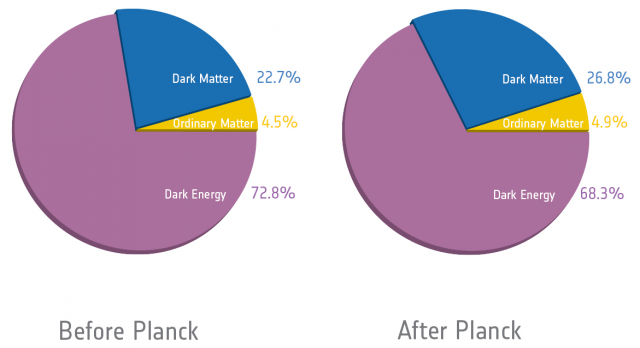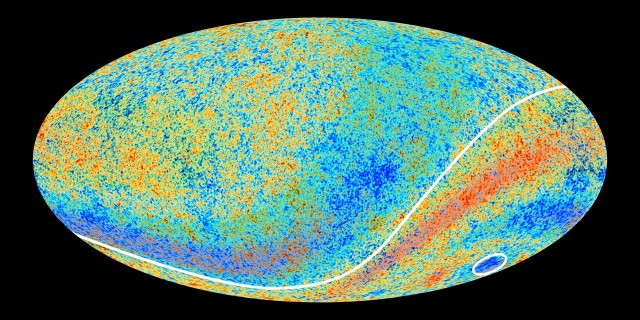
Our current model of cosmology—the origin and structure of the whole Universe—has survived another major test, with the release of the first 15 months of data from the Planck mission. Planck is a European Space Agency mission, designed to study the cosmic microwave background (CMB), which preserves information about the conditions that persisted immediately after the Big Bang.
Combined with results from prior experiments, Planck has revealed a Universe a little older than previously thought, and with a slightly different balance of ingredients. Although there were no major surprises, some of its data provided stronger hints about inflation, a popular model that explains why the modern Universe looks the way it does. Other measurements ruled out extra neutrinos, provided even stronger evidence for the existence (though not the identity) of dark matter, and indicated that there's a bit less dark energy than previous measurements had suggested.
But amid these incremental changes, there was a bit of a surprise: despite the best hopes of researchers, Planck data does not rule out the existence of anomalous temperature fluctuations at large scales. These may hint at either new physics that influenced the Universe's expansion, or previously unknown foreground sources that alter the CMB.
Planck is a phenomenally sensitive instrument, kept at a 0.1° C above absolute zero by the use of liquid helium. By placing it at a stable point beyond Earth's orbit, the probe has a nearly uninterrupted view of the whole sky (this is better than Earth orbit, where it would experience day-night cycles and blockage of much of the sky by Earth's bulk). Since its launch in 2009, Planck has mapped the entire sky in microwave and submillimeter light, creating a 5 million pixel image of the temperature fluctuations from when the Universe was very young.
That image helps tell us the Universe's age. Analysis of Planck data showed a slightly slower cosmic expansion rate, which means it took a bit longer to get to its current state. This nudges the age of the Universe upward to 13.81 billion years (with a margin of error of 50 million years either way). This is a marginal increase over the 13.77 billion year estimate, provided by the WMAP mission in combination with other observations.
Tiny fluctuations have big meanings
After the Big Bang, the cosmos was an opaque plasma, with too much energy to allow electrons and protons to form stable atoms. As it expanded, the Universe cooled, with stable atoms forming around 380,000 years after the Big Bang in an event known as recombination. This act both turned the Universe transparent and released photons, many of which have traveled uninterrupted into the modern era.
While these photons were in the ultraviolet range at the time of recombination, the expansion of the Universe cooled the photons as well, so today they lie in the microwave portion of the spectrum. For this reason, the light is known as the cosmic microwave background.
Planck's mission is to record these photons, which tell us about fluctuations in temperature at the earliest times in the Universe's history. These fluctuations exist at many scales; their physical size on the sky and temperature variation reveal the composition and structure of the Universe. Together, these fluctuations are known as the power spectrum. The largest fluctuations are the result of the total energy content of the Universe—dark energy, dark matter, ordinary matter, light, and anything else. Smaller fluctuations are due to matter alone, and they reveal the relative amounts of ordinary compared to dark matter and how that matter clumps together.

By comparing theoretical models to the real CMB, cosmologists determined that dark energy—the mysterious substance driving cosmic acceleration—comprises 68.3 percent of the energy content of the Universe, down slightly from earlier estimates of 72.8 percent. Similarly, dark matter's contribution was boosted from 22.7 percent to 26.8 percent, while ordinary matter's share went from 4.5 percent to 4.9 percent.
These adjustments largely came from an increase in the trustworthiness of power spectrum at smaller scales, where the effect of dark matter became more important. Comparing the earlier data on the third peak of the power spectrum to the Planck data leaves no doubt about the existence of dark matter (not that there was much prior to that). The fluctuations at even smaller scales agree with surveys of galaxies that measure the effect of sound waves in the early Universe, known as baryon acoustic oscillations.
The weird side of the CMB
One of the major challenges for any CMB measurement is confusion from the foreground. The Milky Way and other sources emit light at some of the same wavelengths as the CMB, so these effects need to be subtracted before a full CMB analysis can be performed. However, even with these foregrounds gone, both the Planck and earlier WMAP data still showed an anomalous set of fluctuations on very large scales (meaning they take up large areas of the total sky). In this case, one part of the sky seems warmer than the rest but contains an unusual "cold spot."

To put it mildly, these anomalies are not well understood. Planck researcher George Efstathiou even suggested in the announcement press conference that they could be hints of an earlier stage of the Universe preceding the Big Bang. Other more prosaic explanations are also possible, including foreground microwave sources from objects that aren't known and haven't been predicted.
Earlier cosmology data hinted that a fourth species of neutrino could exist (in addition to the known electron, mu, and tau neutrino species), but those hints were ambiguous. The new Planck results ruled that idea out, with the most likely number of neutrino species standing at 3. Additionally, Planck placed an upper bound on the sum of all three neutrino masses to be 0.85 eV, or about 0.0002 percent of the mass of an electron.
One final piece from the power spectrum, known as the spectral index, indicates how fluctuations depend on size. Models for inflation predict a number slightly smaller than 1 for the spectral index; Planck data shows a value of about 0.96, with errors small enough so they don't overlap with 1. While it's too soon to say that this is a verification of inflation, it's a strong hint in that direction.
The true tests of inflation—and of Planck's full prowess—will be revealed with the release of the polarization data, currently slated for early 2014. The polarization of different regions of the CMB may record a direct indication of the Universe's rapid expansion (called inflation) in its earliest moments. Planck's supply of liquid helium will be exhausted shortly after that, bringing the scientific mission to an end. But the data it has and will provide will keep cosmologists busy for a while.
The full list of Planck papers may be found at the ESA site; all will be published by Astronomy and Astrophysics.
reader comments
58